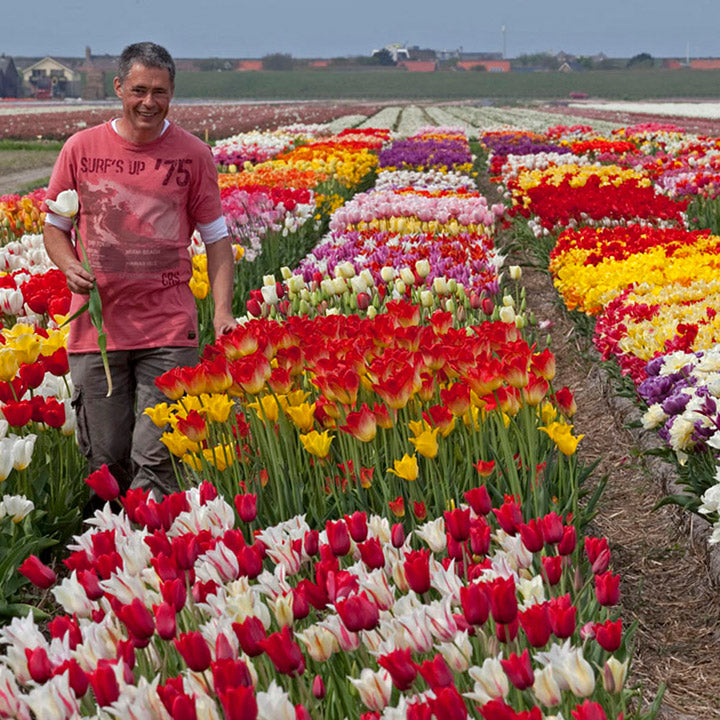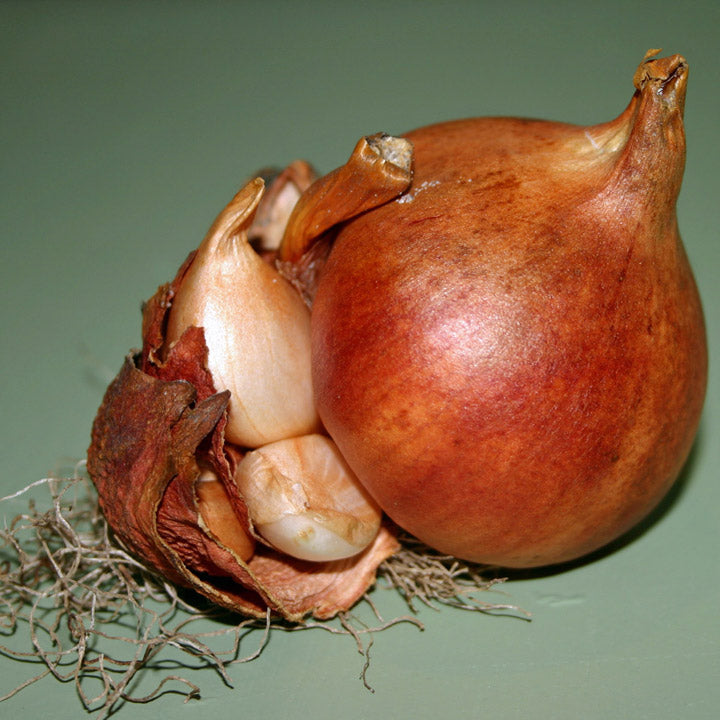As a webshop, we know better than anyone that the customer is king. We will therefore always do our best to meet the needs of our customers and to give them what they want. In recent years, there has been a question among our customers that is not only very important for the consumer, but also for us as an exporter and producer: how environmentally harmful is the flower bulb sector? Are the bulbs that I buy from you 'organic'? Are you, as a flower bulb company, bad for the environment?
Important questions from our customers. Not only for them, but also for us. Because we as bulb farmers want nothing more than a healthy environment for us and our flower bulbs. We want to be able to deliver the best possible quality to you. That is why we would like to tell you about the environmental friendliness of the bulb sector.
We would like to start by distinguishing a number of concepts that are often unclear: sustainable, organic and environmentally friendly.
- Sustainable means that something has a long lifespan. With sustainable development we can meet the needs that are important now without compromising the needs of future generations.
- Organic means that something is made of biological materials, or has emerged from a growth process. Organic is synonymous with biological and organic farming or production means that as little as possible to no pesticides or environmentally harmful agents are used.
- Environmentally friendly means that the natural habitat of plants and animals is taken into account. In environmentally friendly we try to disturb this natural habitat as little as possible and change it as little as possible.
Sustainability at Fluwel
What people wonder is to what extent these concepts apply to Fluwel. Of course, we are happy to answer that question. We start with the sustainability of Fluwel.
When we think of sustainability, we don't just think about what happens on the land, but also about what's going on inside the bulb shed. This includes, for example, the electricity we use. First of all, we would like to tell you that one of our largest investments can be found on the Belkmerweg, namely a windmill.
This windmill is good for about 5 million kWh annually. In 2015, this was 5,111,111 kWh to be exact. Our company's consumption in that year was 428,459 kWh, which resulted in a surplus of 4,682,652 kWh. We supplied this surplus to the energy market, with which we contributed to the use of green energy in the Netherlands!
Then we come to the concept of organic. We can promise you that all the bulbs we export will be sent to you in the same condition as when they arrive. We do not add any pesticides or protection agents. Fluwel itself is therefore completely organic in this area. But we also receive the flower bulbs from outside, from various growers. And of course we cannot say that these bulbs have never seen a pesticide or crop protector. That is why we prefer to explain to you how the bulb sector is doing in general, so that you can plant your bulbs in the garden with peace of mind this autumn.
Environmental friendliness within the Dutch flower bulb sector
The flower bulb sector has a bad image. It is supposedly bad for the environment, because of the large amount of unsafe, extremely toxic pesticides and the amount of machinery involved. There is a lot to be said about that opinion. The use of pesticides cannot be denied, of course, but there are strict rules for that.
Pesticides for flower bulbs must comply with the same laws as pesticides used for food. Flower bulbs are, with the means that are permitted for this, not poisonous to humans. For example, we could even eat our tulips (which also happened in the Second World War). To ensure that the regulations are complied with, there is the BKD, the Flower Bulb Inspection Service, and other investigative bodies of the agricultural world, such as the PD, the Plant Protection Service. They inspect the bulbs that are exported, and are therefore actually a kind of flower bulb police.
How did the flower bulb world get this bad name? That is probably because for a while things were indeed going badly with the environment, in many areas. In the late 80s, early 90s, this received a lot of attention and people started to realize that this could be done differently. During this time, at the beginning of the 90s, action was taken by the government, the flower bulb sector itself and Leiden University.
A step-by-step plan has been drawn up to make flower bulb cultivation more environmentally friendly, so to reduce the use of pesticides as much as possible. In a report that was drawn up at the time, the development of the flower bulb sector in the years 1996 to 2000 was recorded. We will link you to the report itself below, but because it contains 97 pages, we will summarize the most important points for you here.
Agreements made during this consultation have been recorded in the covenant “Implementation of the agreement Environmental Policy Flower Bulb Sector.” The agreements mainly concerned the use of protection and pesticides. A number of objectives have been set, which have been amply achieved. Even more has been achieved than was originally planned! Since the 1990s, the use of pesticides in the bulb sector has dropped to a level that we did not think we could achieve.
There are also other advances, namely breeding. Over the years, well-targeted breeding has resulted in an increasingly healthy bulb and flower, which are less susceptible to diseases, which also means that fewer protective measures are needed.
Another good example of environmentally friendly control is inundation, or: flooding the land. This drowns all nematodes and other unfavourable soil life that could harm the bulbs. This is, according to many growers and WageningenUR, one of the most innovative and environmentally friendly changes in the sector. There is no shortage of water in North Holland, and the flooded fields often provide beautiful, picturesque images as well.
For some bulb growers, the use of pesticides is already a thing of the past. If you are interested in this, you can take a look at our organic flower bulbs from Huiberts flower bulbs. They are one of the companies that can completely exclude the use of pesticides. They grow their bulbs 'in cooperation with nature', in a completely organic way. This way of growing flower bulbs is fortunately becoming increasingly popular and is also getting more and more attention!
Reputation
But, we now think, why then this doubt?
The use of pesticides has been questioned a lot by organisations such as HZL (formerly Houd Zijpe Leefbaar, now Het Zijper Landschap). They have expressed their concerns about flower bulb cultivation in a TV programme and have questioned the inspections of the CTGB. The CTGB, the Board for the Authorisation of Plant Protection Products and Biocides, is a government organisation that strictly approves pesticides and also monitors their use.
However, we at Fluwel are convinced of the knowledge of this organization. They approve the pesticides used in flower bulb cultivation according to the same standards as the pesticides for the food sector.
There were also doubts about the risks of pesticides for growers and residents. Since the CTGB did not conduct specific research into this, this was done later at the request of HZL by Utrecht University (link below). This research examined whether pesticides could be detected in the house dust of residents and growers. Six substances that occur in pesticides have been shown to be present in the house dust of growers. Three of the tested substances can also be present in residents. However, as stated in the research itself, this only says something about the detectability of the substances. The risks remain unknown, although the quantities of the substances detected are so low that a health risk is almost ruled out. It should also be noted that this research dates from 2002. That does not seem long ago, but developments are rapid.
Another foundation that wants to raise awareness for the environmental friendliness of the flower sector is Stichting Bollenboos. However, this foundation is located in Drenthe and focuses on the use of pesticides for lilies. The use of pesticides is considerably higher for lilies. This is a much more difficult crop that requires much more crop protection to, in short, not rot away. Fluwel itself does not have lilies, and therefore does not have to deal with the protection and control measures that come with them.
Why do we use pesticides?
The question then remains why the resources are necessary. One reason for this is that the flower bulbs are inspected extremely strictly. They must be absolutely free of every possible disease that exists. This is, on a large scale and for the average grower, an impossible task without the use of chemical resources. Some growers will therefore also say that it was simply stupid that the BKD (flower bulb inspection service) ever accepted the foreign regulations regarding bulb export. The growers themselves know that impurities that remain on a bulb that is exported are completely harmless. But the rules are there and must of course also be complied with.
Another factor is that the flower bulb sector does not have its own research into pesticides, and that is why they are not used as little and as efficiently as they could be. The reason for this is that, in the Netherlands, the flower bulb sector is only a small part of the total export market. There is simply no budget to do research into pesticides for flower bulbs alone. That is why we have to work with the resources that are available, and flower bulbs are often given resources that work well for other plants, food or fruit trees, and that should therefore also help flower bulbs. As a result, people know that things could probably be better, but that there is no time and money for this. This is not only frustrating for you and the environment, but also for the bulb growers themselves!
The energy consumption
In addition to the use of pesticides, there is also energy consumption. WageningenUR has conducted research into this, which has led to a number of conclusions:

The images below show that energy use at flower bulb companies is decreasing significantly. There is also an increase in the use of sustainable energy. These are positive changes that the companies themselves are doing everything they can to ensure that these changes can continue on an equal footing.

What do we think?
At Fluwel we would like to conclude that the bulb sector is not harmless to the environment, but that we are also doing incredibly well. Energy consumption has decreased, the amount of pesticides is at a level that we did not think we could achieve and that is even lower than what the government has imposed on us, and, not unimportant, no damage has ever been demonstrated to local residents and growers themselves. We would also like to tell you once again that it is not the case that the grower only cares about his export income and not about the consequences for the environment.
Flower bulb growers are outdoors people, enjoy their flowers day in day out when the season is there, and therefore do not want to harm the environment. Growers find it terrible when their daffodils are destroyed during cooking or when the soil has prevented the bulbs from growing. We as flower bulb companies are therefore at the forefront of this journey towards making the flower bulb sector sustainable and environmentally responsible, and we will always continue to work to be able to continue doing this under healthy conditions for years to come.
Sources
www.salushi.nl 03/06/2016
http://www.encyclo.nl/begrip/milieuvrienden 03/06/2016
{{store url}} tulip bulbs-eating 03/06/2016
http://www.bkd.eu 03/06/2016
http://www.rijksbegroting.nl/2010/voorvuuring/begroting,kst132832b_27.html 22/06/2016
https://openaccess.leidenuniv.nl/handle/1887/11555 03/06/2016
http://www.huibertsbloembollen.nl 03/06/2016
http://www.hzl.nl 03/06/2016
http://www.ctgb.nl 03/06/2016
http://content1d.omroep.nl/ 03/06/2016
http://www.bollenboos.nl 03/6/2016
http://www.agrimatie.nl/SectorDashboard.aspx 03/06/2016

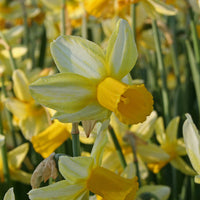



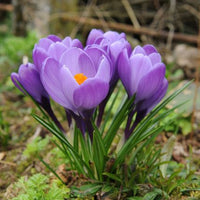



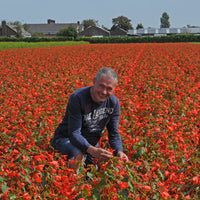
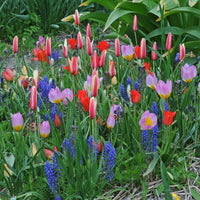


 Deutsch
Deutsch English
English